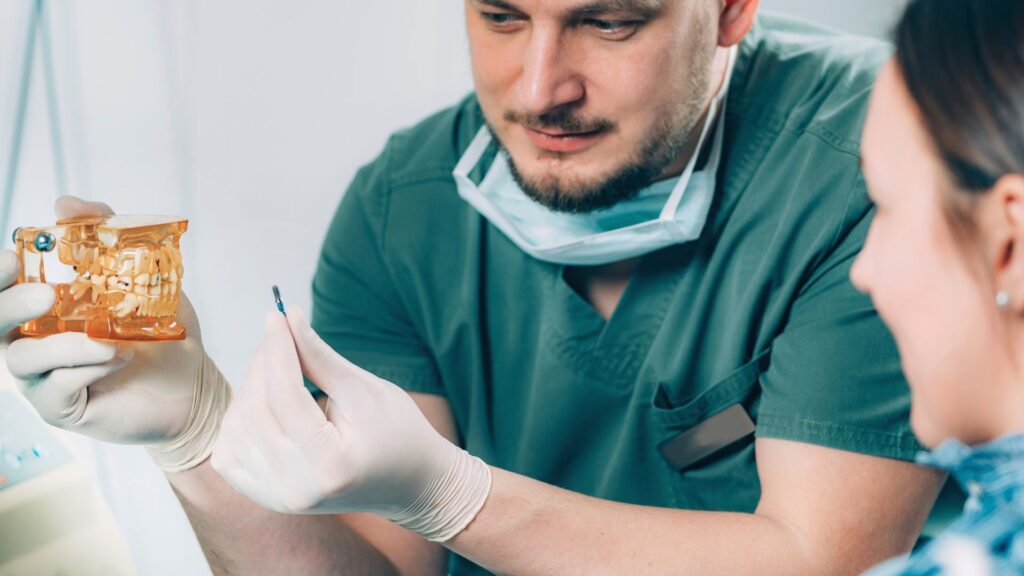If you’ve lost a tooth or need a long-term solution for missing teeth, dental implants in Mira Road are one of the most trusted ways to restore your smile. They look, feel, and work just like real teeth, but many people feel unsure about what the process actually involves.
Whether you’re exploring your options or already planning a consultation with a dentist in Mira Road, understanding the whole procedure step by step can help you feel more confident and prepared. This guide breaks it down clearly so you know what to expect at every stage.
What Is a Dental Implant?
A dental implant is a titanium screw that acts as a replacement root for a missing tooth. It is placed into the jawbone and supports a crown, bridge, or denture, depending on the number of teeth being replaced.
Implants are recommended when one or more teeth are missing due to injury, decay, or age-related loss. To be a candidate, you should have healthy gums, good bone density, and no primary health conditions that affect healing.
Step-by-Step Dental Implant Procedure
Getting a dental implant involves multiple stages, each important for long-term success. Here’s what the process typically looks like:
1. Initial Consultation and Diagnostic Imaging
The process starts with an oral exam, X-rays, or CBCT scans. Your dentist checks your gum health, bone condition, and overall suitability for implants. This step helps build a personalized treatment plan that considers your health, jaw structure, and any medical conditions that may affect healing.
2. Tooth Extraction (If the Tooth Is Still Present)
If a damaged or decayed tooth is still in place, it must be removed. The extraction is done under local anesthesia. In some cases, an implant can be placed right after the extraction, but only if the bone is healthy enough to support it.
3. Bone Grafting (If Required)
If your jawbone is too thin or weak, a bone graft may be needed. Grafting material helps rebuild the area and creates a strong foundation for the implant. Healing from grafting can take several months, depending on how much bone is needed.
4. Implant Placement Surgery
Once the bone is ready, a titanium implant is placed into the jawbone under local anesthesia. This minor procedure usually takes less than an hour for one tooth. A healing cap or cover screw is placed over the implant to protect it during recovery.
5. Healing Phase (Osseointegration)
Over the next 3 to 6 months, your bone fuses with the implant. This process, called osseointegration, provides a stable base for your new tooth. Good healing habits, oral hygiene, and health all contribute to long-term success.
Implant procedures may require multiple visits spread over several months. Healing and integration time varies based on individual bone structure and health.
6. Abutment Placement
After healing, a small metal connector called an abutment is attached to the implant. This connects the implant to the crown. Sometimes a second small procedure is needed to expose the implant if it was covered by gum tissue.
7. Crown Placement and Final Restoration
A custom-made crown is fixed to the abutment. It is designed to match your natural teeth in shape and color. Once in place, it functions like a real tooth. With proper care, the final result can last for many years.
How Long Does the Dental Implant Procedure Take?
The total timeline depends on your bone health, how many teeth need to be replaced, and whether bone grafting is involved. For a single implant without grafting, the process may take 3–4 months. With bone grafting, it can take 6–9 months.
Table: Timeline Overview of Dental Implant Procedure
|
Stage |
Description |
Approximate Duration |
| Initial Consultation | X-ray, CBCT, oral exam | 1 day |
| Tooth Extraction (if needed) | Removal of damaged tooth | 1–2 days |
| Bone Grafting (if required) | Graft placed to support implant | Heals in 3–6 months |
| Implant Placement | Titanium post inserted into bone | 1–2 hours |
| Healing Period | Implant fuses with jawbone | 3–6 months |
| Abutment Placement | Connector attached to implant | 1–2 weeks healing |
| Crown Placement | Final artificial tooth attached | 1–2 appointments |
Does It Hurt?
Most patients report only mild discomfort during and after the procedure. Local anesthesia is used during surgery to ensure you don’t feel pain. After the surgery, it’s common to experience some swelling or tenderness, which usually settles within a few days with medication.
As per a 2024 report by the National Oral Health Programme (NOHP), dental implant adoption in India has grown by 30% over the last five years, particularly in urban clinics.
What Is the Cost of Dental Implants in India?
The cost of dental implants can vary based on several factors:
- Brand and type of implant used
- Whether bone grafting or extraction is required
- Number of teeth being replaced
- Location of the dental clinic
- Type of prosthetic used (metal, ceramic, zirconia)
In India, a single tooth implant may range between ₹25,000 to ₹55,000, while full mouth restorations can go upwards of ₹2,00,000.
Success Rates and Risk Factors
Dental implants have a high success rate of 90–98% when placed under proper conditions. However, like any surgical procedure, there are risks, such as:
- Infection around the implant
- Implant not integrating with bone
- Nerve damage (rare)
- Sinus issues for upper jaw implants
Maintaining good oral hygiene and avoiding smoking can significantly improve the chances of long-term success.
According to the Indian Dental Association, dental implants have a success rate of over 95% when placed under proper clinical conditions.
FAQs
How long does a dental implant take from start to finish?
A complete implant process can take anywhere from 3 to 9 months, depending on the complexity, healing time, and whether additional procedures like grafting are required.
Is getting a dental implant painful?
Most patients experience only mild discomfort due to local anesthesia. Any post-surgery soreness is manageable with standard pain relief.
What factors affect the cost of a dental implant in India?
The price depends on the brand of the implant, clinical complexity, the dentist’s experience, and whether additional procedures, like grafting, are involved.
Do I need a bone graft for a dental implant?
Bone grafting is sometimes required when there is insufficient bone to hold the implant securely. Your dentist will decide based on X-rays or CT scans.
How long does it take for a dental implant to heal?
The healing phase (osseointegration) typically takes 3 to 6 months, during which the implant fuses with the jawbone for long-term stability.
Are dental implants safe for everyone?
Dental implants are generally safe, but people with uncontrolled diabetes, smoking habits, or certain health conditions may need special care or alternatives.
Conclusion
Dental implants offer a safe and long-term solution for replacing missing teeth, provided the procedure is carried out with proper care and planning. The process requires time, but each stage plays a role in ensuring strength, stability, and function.
If you’re thinking about restoring your smile, it’s best to consult a qualified dentist in Mira Road who can evaluate your needs and guide you through every step of the process.








